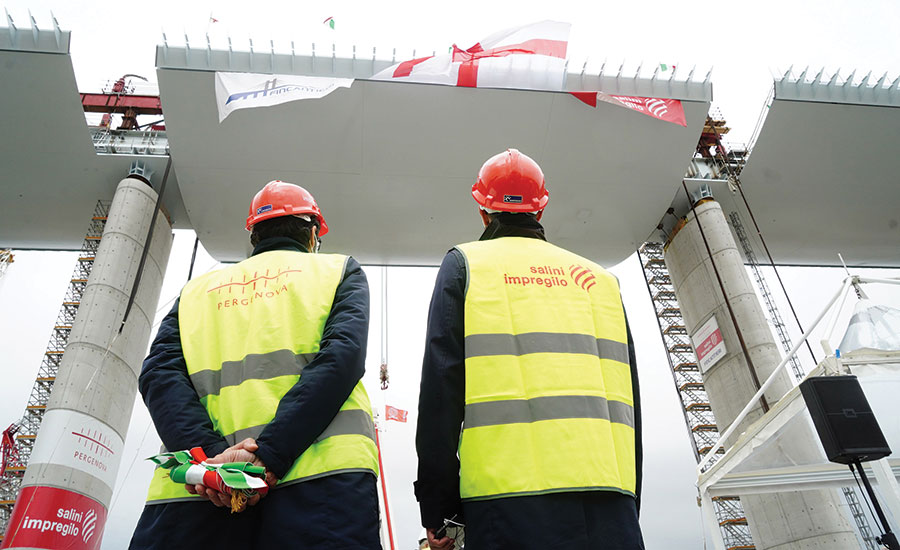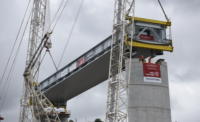About 20 months after the 1.1-km-long Polcevera viaduct in Genoa, Italy, collapsed and caused 43 deaths, the last span of its replacement went up the week of April 27. Bad weather and the coronavirus frustrated the contractor’s ambitions to complete steelwork erection as originally planned by February, but construction has still been rapid since its start last April.
Fast-tracking multiple operations, nonstop work at the site and individuals putting in 16 to 18 hours a day helped maintain the pace of construction, says Francesco Poma, the project director of the joint venture PerGenova. But given the enormity of the bridge disaster, “a sense of duty” was also in the mix, he adds.
Designed by locally based architect Renzo Piano with structural engineers from Italferr S.p.A., the $220-million replacement bridge has a 1,067-m-long steel box girder deck crossing the Polcevera Valley on 18 concrete piers rising some 45 m above ground. Roughly 27 m wide, most of the 19 deck spans are around 50 m long, with three extending 100 m over the Polcevera River, a highway and railroad tracks.
The PerGenova consortium of Salini Impregilo S.p.A. and the construction unit of state-controlled shipbuilder Fincantieri S.p.A. placed the first 50-m-long steelwork span in October and raised the last one on April 28 in a ceremony led by Prime Minister Giuseppe Conte.
Because the viaduct weaves between buildings and crosses transportation corridors, PerGenova used two methods to erect the deck, says Poma. For five spans, including the three longest, the contractor lifted entire deck sections with strand jacks. But for the rest, large cranes raised only the central 7-m-wide spine box sections of deck, with the contractor adding the projecting sides later.
Work will now start to settle the entire deck onto permanent pier top bearings and adjust the movement joints at both abutments. Then, in May, crews will start laying the concrete roadway ahead of the crossing’s opening at some unspecified date.
PerGenova gained access to the site April 2019, while demolition on the collapsed viaduct was still going on. It wasn’t fully removed until September, says Poma. PerGenova fast-tracked site clearance, design and fabrication, and started work in some areas while still waiting for official approval in others, he adds.
The project was hit by the worst winter “in decades” and the pandemic. Only one employee, now well again, contracted COVID-19, triggering self isolation of immediate co-workers, says Poma. Revamping worker housing and dining areas, enforcing safe working distances and using protective equipment and body temperature monitoring helped mitigate virus risk among the 350-person workforce.
[For ENR’s latest coverage of the impacts of the COVID-19 pandemic, click here]
RINA Consulting, the firm tasked with project and health and safety management for both the demolition and reconstruction, says the project team to date has created more than 3,000 technical documents and conducted around 600 technical, quality and safety audits and 2,000 material and structural element inspections.
Raising of the final span "is a demonstration that Italy is a country that can continue to function and to be strong even in the most difficult moments, and that its people can demonstrate great managerial and operational skills," said Roberto Carpaneto, RINA CEO. "This viaduct is an important symbol for the restart of the country and a reference point for everyone."


